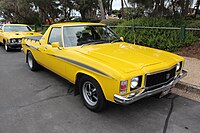
The Holden Monaro is a rear-wheel drive coupé manufactured by General Motors Holden in Australia from 1968 to 1975 and later reintroduced from 2001 to 2005. It was also manufactured as a 4-door saloon from 1973 to 1977.

Holden Special Vehicles (HSV) was the officially designated performance vehicle division of Holden. Established in 1987 and based in Clayton, Victoria, the company modified Holden models such as the standard wheelbase Commodore, long wheelbase Caprice and Statesman, and commercial Ute for domestic and export sale. HSV also modified other non-Holden cars within the General Motors lineup in low volumes.

The Holden Kingswood is a full-size car that was manufactured in Australia by Holden, from the beginning of the HK series in 1968 through to the conclusion of the WB series in 1984. Prior to 1968, the full-size Holden range of family cars comprised the Holden Standard, the Holden Special, and Holden Premier models. Initially, the HK range of models included the basic Holden Belmont, the Kingswood, and the luxury-oriented Holden Premier, all of which were manufactured in a choice of sedan and station wagon bodies. Commercial variants were offered in three types: coupé utility, panel van, and later from 1971, a heavy-duty Holden One Tonner cab chassis. The utility (ute) version was originally marketed in both Belmont and Kingswood configurations. However, after the Belmont name was deleted from commercials at the end of HQ in late 1974, the base model commercials were sold only with the "Holden" badge.

A panel van, also known as a blind van, car-derived van or sedan delivery, is a small cargo vehicle utilizing a passenger car chassis, typically with a single front bench seat and no side windows behind the B-pillar. Panel vans are smaller than panel trucks or cargo vans, both of which utilize body-on-frame truck chassis.

The Holden Ute is a coupe utility built by Holden, the Australian subsidiary of General Motors, since 2000. Before then, Holden had marketed their Commodore-based utility models under the Holden Utility (VG) and Holden Commodore utility names, although the term “Holden Ute” was also used in their official marketing literature. The Holden Ute name is often used for earlier Holden Utility models as the word "ute" is a colloquial term used commonly in Australia for a utility vehicle or pickup truck. Holden's performance division, an independent company called HSV assembles a high-performance version called the Maloo. Between 2003 and 2007, Holden built a stretched, crew cab version of the Ute with four doors and seating for five, called the Holden Crewman and between 2003 and 2005 a cab-chassis version known as the Holden One Tonner.

The Ford Falcon (XW) is a full-size car that was produced by Ford Australia from 1969 to 1970. It was the third iteration of the second generation of this Australian-made model and also included the Ford Futura (XW) and the Ford Fairmont (XW)—the luxury-oriented version of the Falcon.

The Holden HQ series is a range of automobiles that was produced by Holden in Australia from 1971 to 1974. The HQ was released on 15 July 1971, replacing the Holden HG series. It was the first ground up redesign of the Holden line since its original release in 1948, and included an all-new body, chassis, and suspension. The HQ was later developed into a series of successor models, finally ending production when the WB series was discontinued in 1984.

The Holden HK series is an automobile which was produced by Holden in Australia from 1968 to 1969. Introduced in January 1968, the HK range progressively replaced the Holden HR series which had been in production since 1966. HK models were both larger and heavier than their predecessors and the range would ultimately include thirteen different models against the eight of the HR range. The Holden HK was marketed under Belmont, Kingswood, Premier, Brougham and Monaro model names.

The Holden EJ is a motor vehicle produced by General Motors-Holden's in Australia from 1962 to 1963. Introduced in July 1962, the EJ replaced the Holden EK series.

The Holden HX is a range of automobiles which was produced by Holden in Australia from 1976 to 1977.

Holden HZ is a full-sized automobile which was produced in Australia between October 1977 and April 1980 by Holden in a variety of equipment levels and in several different body styles. It was also assembled in New Zealand.

The Holden WB series is an automobile which was produced by Holden in Australia from 1980 to 1984. It is a facelifted version of the Holden HZ series, which it replaced. Unlike the HZ and every other full size Holden series before it, the Holden WB was only offered in commercial vehicle bodystyles with no sedan or wagon passenger car variants. The long-wheelbase WB series models were marketed under the separate Statesman marque, absent of all Holden branding.

The Holden FB is an automobile produced by Holden in Australia from 1960 to 1961. Introduced on 14 January 1960, the FB series replaced the Holden FC range.

The Holden HT series is a range of automobiles which was produced by Holden in Australia between 1969 and 1970.

The Holden HG is an automobile which was produced by Holden in Australia between 1970 and 1971. It was marketed under Belmont, Kingswood, Premier, Brougham and Monaro model names.

The Holden HD series is a range of automobiles which were produced by Holden in Australia from 1965 to 1966.

The Holden HR is an automobile that was produced by Holden in Australia from 1966 to 1968.

The National Motor Museum, Australia, is an automobile museum in the Adelaide Hills in the township of Birdwood, South Australia. Established in 1964 and opened to the public soon afterwards, it is Australia's largest motor museum, with close to 400 vehicles on display.




































